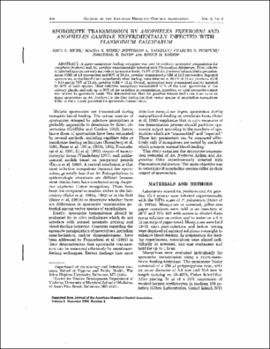| dc.contributor.author | Beier, John C. | |
| dc.contributor.author | Beier, Magda S. | |
| dc.contributor.author | Vaughan, Jefferson A. | |
| dc.contributor.author | Pumpuni, Charles B. | |
| dc.contributor.author | Davis, Jonathan R. | |
| dc.contributor.author | Noden, Bruce H. | |
| dc.date.accessioned | 2022-04-12T13:45:42Z | |
| dc.date.available | 2022-04-12T13:45:42Z | |
| dc.date.issued | 1992 | |
| dc.identifier | oksd_noden_sporozoitetransmission_1992 | |
| dc.identifier.citation | Beier, J. C., Beier, M. S., Vaughan, J. A., Pumpuni, C. B., Davis, J. R., & Noden, B. H. (1992). Sporozoite transmission by Anopheles freeborni and Anopheles gambiae experimentally infected with Plasmodium falciparum. Journal of the American Mosquito Control Association, 8(4), pp. 404-408. | |
| dc.identifier.uri | https://hdl.handle.net/11244/335150 | |
| dc.description.abstract | A micro-membrane feeding technique was used to evaluate sporozoite transmission for Anopheles freeborni and An. gambiae experimentally infected with Plasmodium falciparum. From cohorts of infected mosquitoes with equivalent sporozoite loads, 75.9% of 29 An. freeborni transmitted a geometric mean (GM) of 4.9 sporozoites and 80% of 30 An. gambiae transmitted a GM of 11.3 sporozoites. Ingested sporozoites, in the blood meal immediately after feeding, were detected in 86.2% of 29 An. freeborni (GM = 9.0) and in 70% of 30 An. gambiae (GM = 44.1). Overall, sporozoites were transmitted and/or ingested by 90% of both species. Most infective mosquitoes transmitted < 1% of the total sporozoites in the salivary glands, and only up to 30% of the variation in transmission, ingestion, or total sporozoite output was related to sporozoite loads. The demonstration that An. gambiae transmitted more than twice as many sporozoites as An. freeborni is the first indication that vector species of anopheline mosquitoes differ in their innate potential for sporozoite transmission. | |
| dc.format | application/pdf | |
| dc.language | en_US | |
| dc.publisher | The American Mosquito Control Association | |
| dc.relation.ispartof | Journal of the American Mosquito Control Association, 8 (4) | |
| dc.relation.uri | https://www.ncbi.nlm.nih.gov/pubmed/1474388 | |
| dc.rights | This material has been previously published. In the Oklahoma State University Library's institutional repository this version is made available through the open access principles and the terms of agreement/consent between the author(s) and the publisher. The permission policy on the use, reproduction or distribution of the material falls under fair use for educational, scholarship, and research purposes. Contact Digital Resources and Discovery Services at lib-dls@okstate.edu or 405-744-9161 for further information. | |
| dc.subject.mesh | Animals | |
| dc.subject.mesh | Anopheles | |
| dc.subject.mesh | Humans | |
| dc.subject.mesh | Insect Vectors | |
| dc.subject.mesh | Malaria, Falciparum | |
| dc.subject.mesh | Plasmodium falciparum | |
| dc.subject.mesh | Salivary Glands | |
| dc.subject.mesh | Species Specificity | |
| dc.title | Sporozoite transmission by Anopheles freeborni and Anopheles gambiae experimentally infected with Plasmodium falciparum | |
| dc.date.updated | 2022-04-07T15:16:48Z | |
| osu.filename | oksd_noden_sporozoitetransmission_1992.pdf | |
| dc.description.peerreview | Peer reviewed | |
| dc.description.department | Entomology and Plant Pathology | |
| dc.type.genre | Article | |
| dc.type.material | Text | |
| dc.subject.keywords | Rare Diseases | |
| dc.subject.keywords | Vector-Borne Diseases | |
| dc.subject.keywords | Malaria | |
| dc.subject.keywords | Infectious Diseases | |
| dc.subject.keywords | 2.2 Factors relating to the physical environment | |
| dc.subject.keywords | Infection | |
| dc.subject.keywords | 0608 Zoology | |
| dc.subject.keywords | 1117 Public Health and Health Services | |
| dc.subject.keywords | Tropical Medicine | |
| dc.identifier.author | ScopusID: 7102003162 (Beier, JC) | |
| dc.identifier.author | ScopusID: 7006044128 (Beier, MS) | |
| dc.identifier.author | ScopusID: 7202772214 (Vaughan, JA) | |
| dc.identifier.author | ScopusID: 6602672869 (Pumpuni, Charles B.) | |
| dc.identifier.author | ScopusID: 7405963291 (Davis, JR) | |
| dc.identifier.author | ORCID: 0000-0002-0096-370X (Noden, BH) | |
| dc.identifier.author | ScopusID: 6601968347 (Noden, BH) | |
